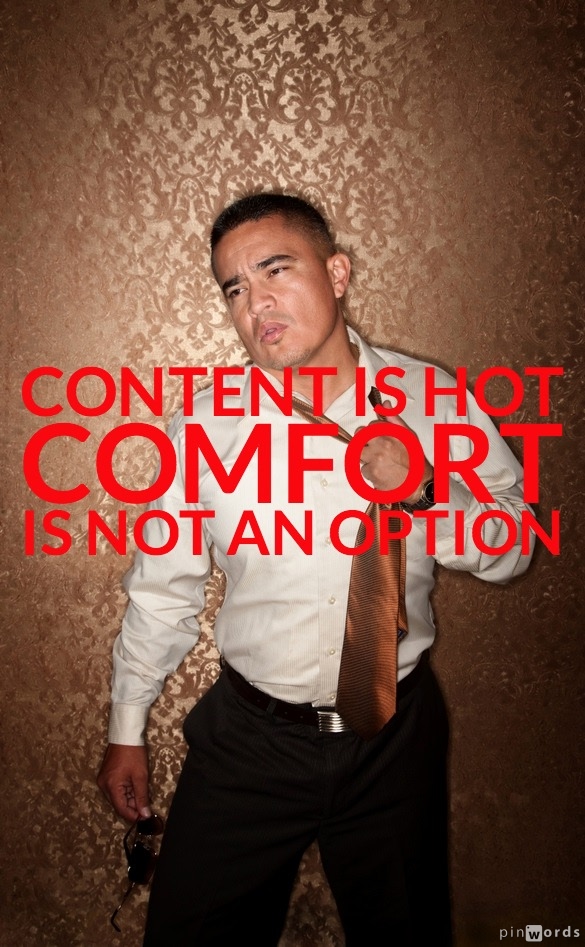
We are either in the middle of a glorious content revolution or a massive content glut.
This is the hottest debate in content marketing right now.
Here’s the theory. Content marketing has become so prevalent—the amount of content hitting our eyeballs each day so vast—that it’s outstripping our ability to consume. So content creation might not be a viable, long-term strategy.
This theory is called “content shock” or “content fatigue,” depending on who you read.
(The debate was first sparked by Mark Schaefer, purveyor of the {grow} blog. But we’ve discussed this as both an internal and external issue, calling it content chaos. You can have your pick of epigrams.)
It’s hard to argue with the economics of this perspective. Our time is limited. Our ability to actually process information is even more limited. And while technology has helped expand the intake valve to our brains, it certainly doesn’t match the torrent of content rushing through the pipe.
Some argue this means that content creation will gradually lose its luster. Or that only those with big money will be able to compete. I argue it means something else—something basic but underappreciated.
If you want to succeed in content marketing, you can’t get comfortable.
Content Marketing Grows Up
Let’s say businesses are on pace to create more content than the market can process. This has already occurred in at least two places: the media, and every other kind of marketing.
There are far too many publications begging you to subscribe. You could never keep up with all of them.
And don’t confuse this for a recent phenomenon. Even in 1870, you could get your mitts on 90 different newspapers in New York City alone. But despite the decline of many traditional newspapers, magazines, and broadcast channels, other outlets—both online and offline—have been able to break through.
Some like BuzzFeed and Upworthy did so by playing with the delivery and audience preference models; others have continued to use long-form editorial practices, but succeeded by adapting the distribution strategy or appealing well to niche interests. (Consider the success of Andrew Sullivan’s blog, Medium, as a delivery vehicle, Grantland among the cluttered sports and culture field, and how plenty of parenting magazines saw circulations hold steady or even grow recently.)
Similarly, many different marketing tactics have risen quickly, only to see overall efficacy rates slide as more businesses rush in.
To produce results, you need to seek out new opportunities, tweak models, explore uncharted territory.
On Schaefer’s own blog, Eric Wittlake rightly points out that the first marketer to use email probably recorded the kind of response we’d salivate over now—though, the sample size of the database we’d dismiss today. And the first banner ad got a 44% click rate, compared to today when 0.1% is “doing fine.”
The takeaway isn’t that these tactics need to be confined to the trash heap of marketing history. It’s that if marketing—any kind of marketing—is going to produce results, you need to seek out new opportunities, tweak models, explore uncharted territory.
Which leads me back to my initial point…
Don’t Get Comfortable
The fact that content production is outpacing the public’s ability to consume doesn’t mean it isn’t a viable strategy. It means that it’s an industry.
Like the media, like other forms of marketing, invention and reinvention are required traits of your content operation if you want to stand out. As content marketing solidifies into a daily practice at most organizations, teams need to not only deliver quality but find novel ways to do it.
The formula is equal parts consistency and creativity. Creativity grabs the stretched buyer’s attention, and consistency keeps them coming back.
The formula is equal parts consistency and creativity.
This means getting comfortable is not an option. And it’s already happening within the content marketing industry. Some of the unique ways we offered insights a few years back (lists, infographics, eBooks, etc.) easily slide into the category of “old standbys.” And standbys get stale.
That’s not to say they’re not useful or effective. In fact, they’re necessary. These are the tools that will carry your brand’s message, insights, and value to the market. And having a defined process, team structure, calendar, and workflow become even more vital as the content space gets more competitive.
Because if your content is to be heard among the crescendo, experimentation is as important as mastering a current skill. But to experiment with the game plan, you first have to have a game plan.
So is content getting hotter? Yes. Time to loosen that collar and get down to work.

